CADILLAC FLEETWOOD 1993 2.G Owners Manual
Manufacturer: CADILLAC, Model Year: 1993, Model line: FLEETWOOD, Model: CADILLAC FLEETWOOD 1993 2.GPages: 386, PDF Size: 19.17 MB
Page 181 of 386
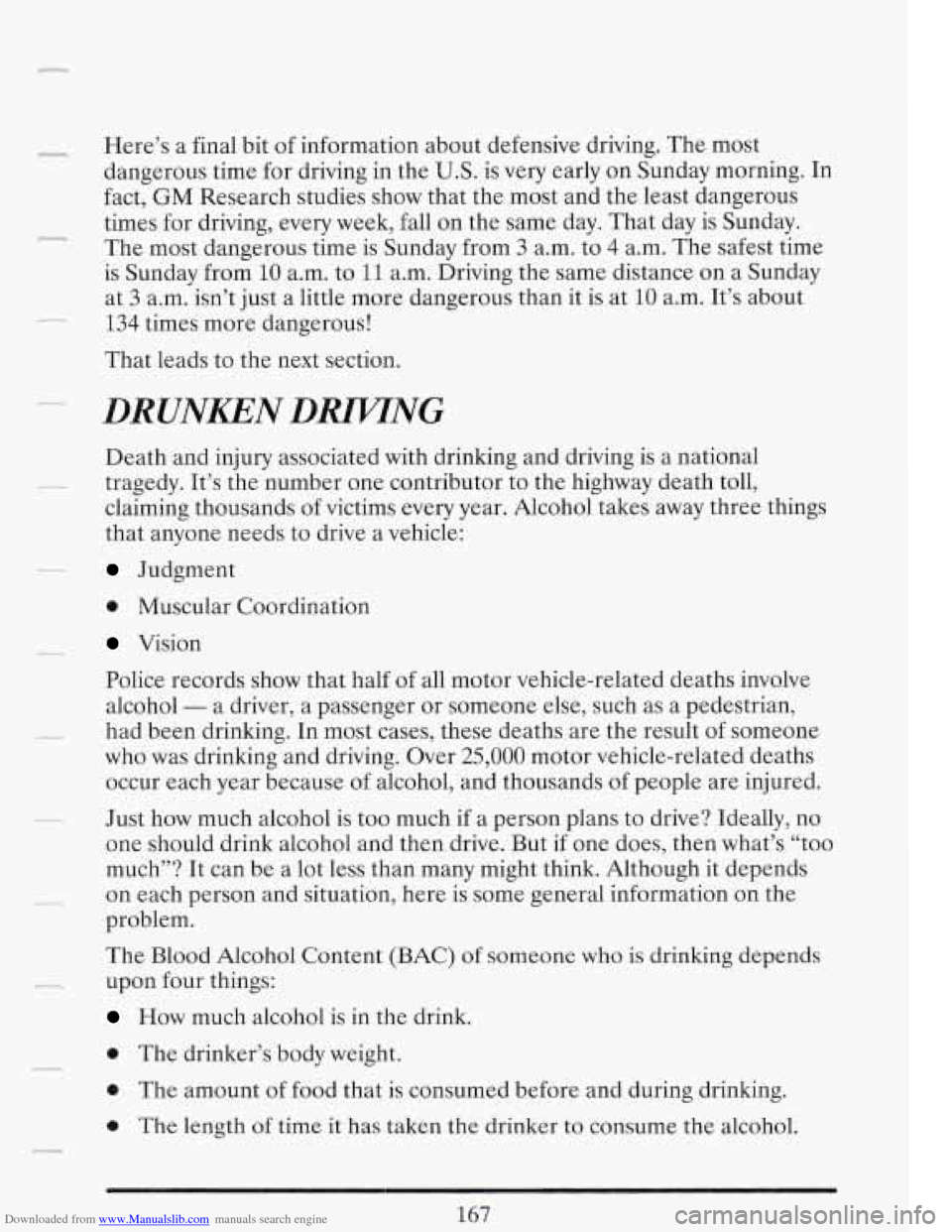
Downloaded from www.Manualslib.com manuals search engine Here’s a final bit of information about defensive driving. The most
dangerous time for driving in the
U.S. is very early on Sunday morning. In
fact, GM Research studies show that the most and the least dangerous
times for driving, every week, fall on the same day. That day is Sunday.
The most dangerous time is Sunday from
3 a.m. to 4 a.m. The safest time
is Sunday from
10 a.m. to 11 a.m. Driving the same distance on a Sunday
at
3 a.m. isn’t just a little more dangerous than it is at 10 a.m. It’s about
134 times more dangerous!
That leads to the next section.
DRUNKElN DMNG
Death and injury associated with drinking and driving is a national
tragedy. It’s the number one contributor to the highway death toll,
claiming thousands of victims every year. Alcohol takes away three things
that anyone needs to drive a vehicle:
Judgment
0 Muscular Coordination
Vision
Police records show that half of all motor vehicle-related deaths involve
alcohol
- a driver, a passenger or someone else, such as a pedestrian,
had been drinking. In most cases, these deaths are the result
of someone
who was drinking and driving. Over
25,000 motor vehicle-related deaths
occur each year because of alcohol, and thousands
of people are injured.
Just how much alcohol is too much if a person plans to drive? Ideally, no
one should drink alcohol and then drive. But if one does, then what’s “too
much”? It can be a lot less than many might think. Although it depends
on each person and situation, here is some general information on
the
problem.
The Blood Alcohol Content
(BAC) of someone who is drinking depends
upon four things:
How much alcohol is in the drink.
0 The drinker’s body weight.
0 The amount of food that is consumed before and during drinking.
0 The length of time it has taken the drinker to consume the alcohol.
167
Page 182 of 386
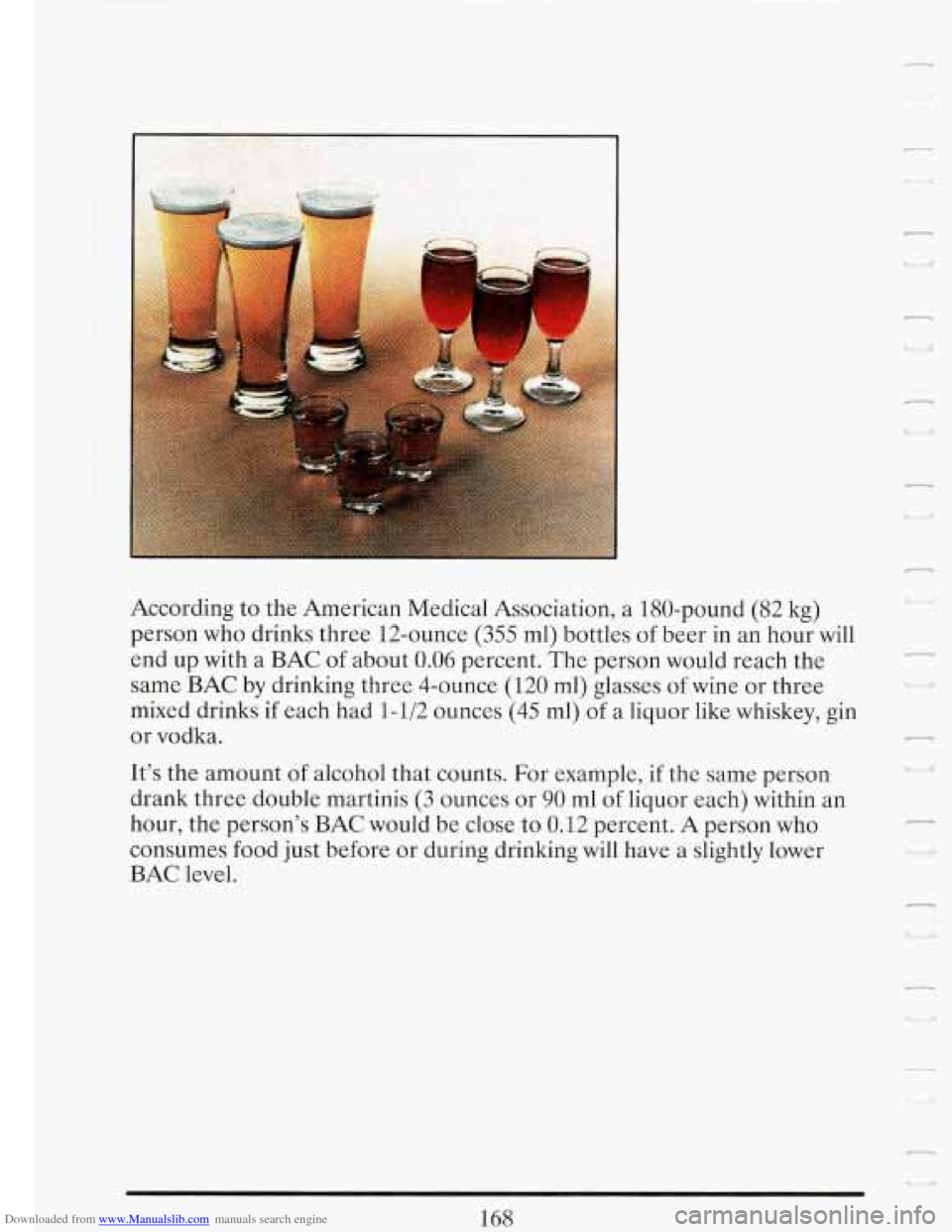
Downloaded from www.Manualslib.com manuals search engine According to the American Medical Association, a 180-pound (82 kg)
person who drinks three 12-ounce (355 ml) bottles of beer
in an hour will
end up with a
BAC of about 0.06 percent. The person would reach the
same
BAC by drinking three 4-ounce (120 ml) glasses of wine or three
mixed drinks if each had 1-1/2 ounces
(45 ml) of a liquor like whiskey, gin
or vodka.
r_
It's the amount of alcohol that counts. For example, if the same person
drank three double martinis (3 ounces or
90 ml of liquor each) within an
hour, the person's
BAC would be close to 0.12 percent. A person who
consumes food just before or during drinking
will have a slightly lower
BAC level.
168
Page 183 of 386
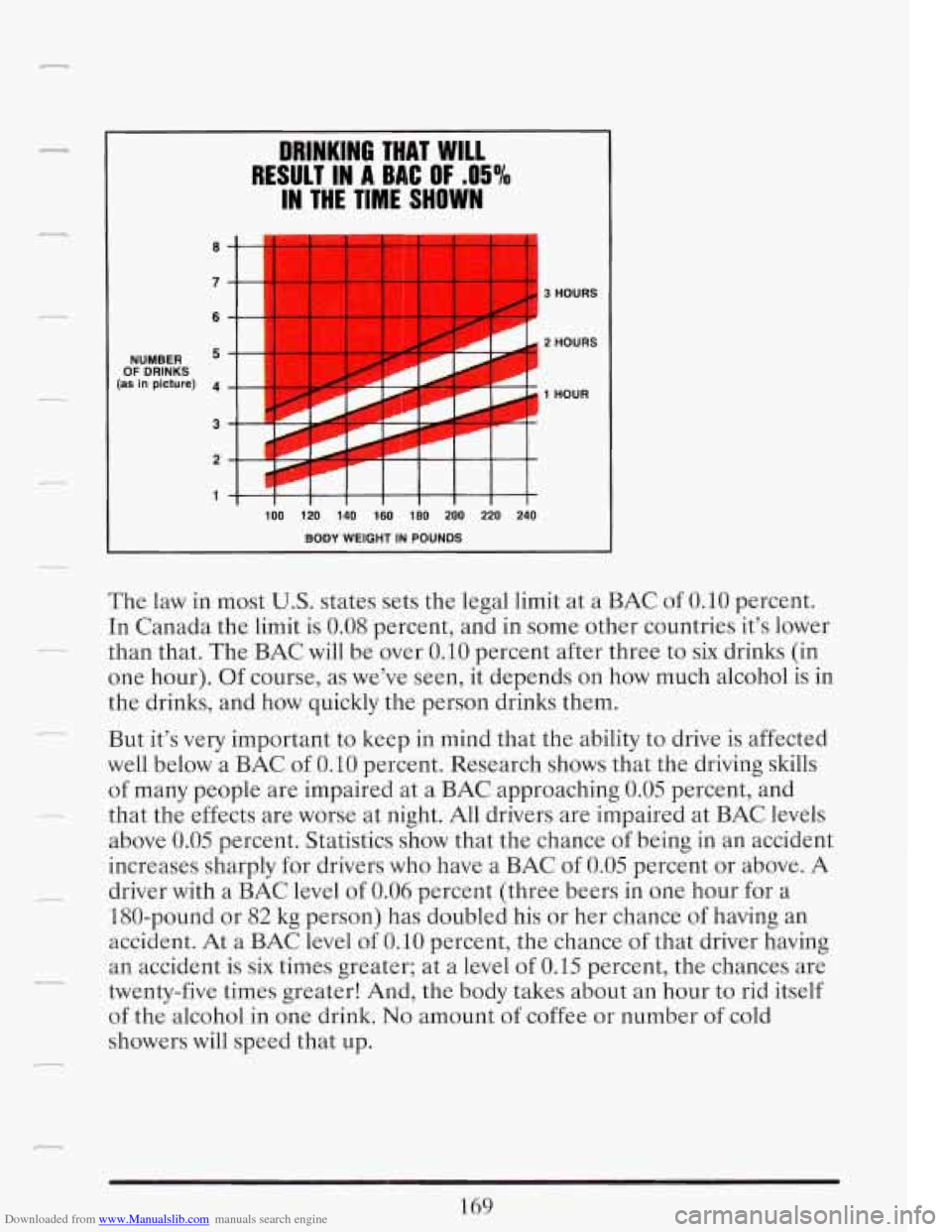
Downloaded from www.Manualslib.com manuals search engine r
r
DRINKING THAT WILL
RESULT IN A BAC OF .05%
IN THE TIME SHOWN
’P 6
~ 3 HOURS
rL 2 HOURS
NUMBER
OF, DR!NKS (as In plcture) 4 1 HOUR
3
2
1
100 120 140 160 180 200 220 240
BODY WEIGHT IN POUNDS
The law in most US. states sets the legal limit at a BAC of 0.10 percent.
In Canada the limit is 0.08 percent, and in some other countries it’s lower
than that. The BAC will be over
0.10 percent after three to six drinks (in
one hour).
Of course, as we’ve seen, it depends on how much alcohol is in
the drinks, and how quickly the person drinks them.
But it’s very important to keep in mind that the ability to drive is affected
well below a BAC
of 0.10 percent. Research shows that the driving skills
of many people are impaired at a BAC approaching 0.05 percent, and
that the effects are worse at night. All drivers are impaired at BAC levels
above
0.05 percent. Statistics show that the chance of being in an accident
increases sharply for drivers who have a BAC
of 0.05 percent or above. A
driver with a BAC level of 0.06 percent (three beers in one hour for a
180-pound or 82 kg person) has doubled his or her chance
of having an
accident.
At a BAC level of 0.10 percent, the chance of that driver having
an accident is six times greater; at a
level of 0.15 percent, the chances are
twenty-five times greater! And, the body takes about an hour to rid itself
of the alcohol in one drink. No amount of coffee or number of cold
showers will speed that up.
169
Page 184 of 386
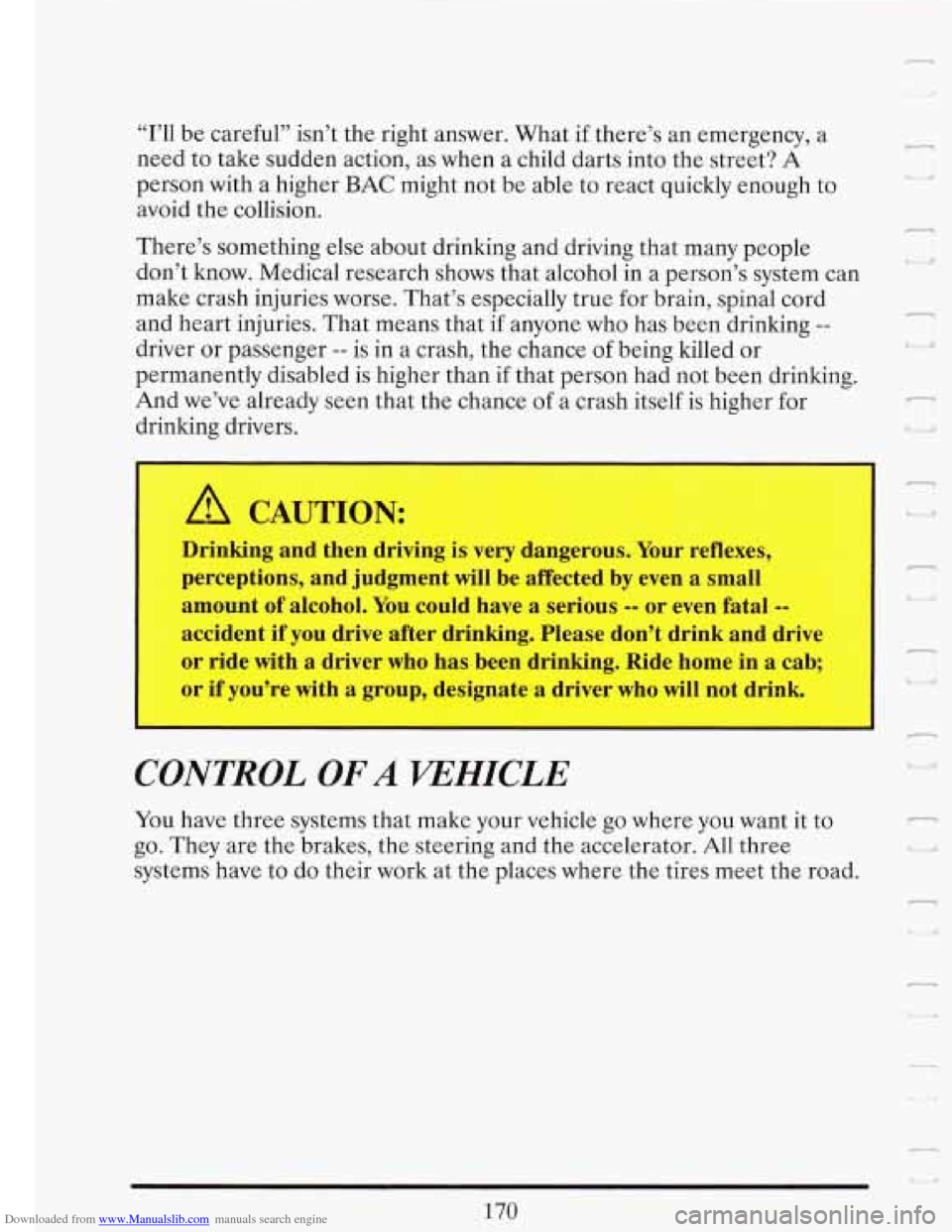
Downloaded from www.Manualslib.com manuals search engine “I’ll be careful’’ isn’t the right answer. What if there’s an emergency, a
need to take sudden action, as when a child darts into the street?
A
person with a higher BAC might not be able to react quickly enough to
avoid the collision.
There’s something else about drinking and driving that many people
don’t know. Medical research shows that alcohol in a person’s system can
make crash injuries worse. That’s especially true for brain, spinal cord
and heart injuries. That means that
if anyone who has been drinking --
driver or passenger -- is in a crash, the chance of being killed or
permanently disabled is higher than
if that person had not been drinking.
And we’ve already seen that the chance of a crash itself is higher for
drinking drivers.
A CAUTION:
Drinking and then driving is very dangerous. Your reflexes,
perceptions, and judgment will be affected by even a small
amount of alcohol. You could have a serious
-- or even fatal --
accident if you drive after drinking. Please don’t drink and drive
or ride with
a driver who has been drinking. Ride home in a cab;
or if you’re with a group, designate a driver who will not drink. I
CONTROL OF A VEHICLE
You have three systems that make your vehicle go where you want it to
go. They are the brakes, the steering and the accelerator.
All three
systems have to do their work at the places where the tires meet the road.
11
d
a ,’ d
170
Page 185 of 386
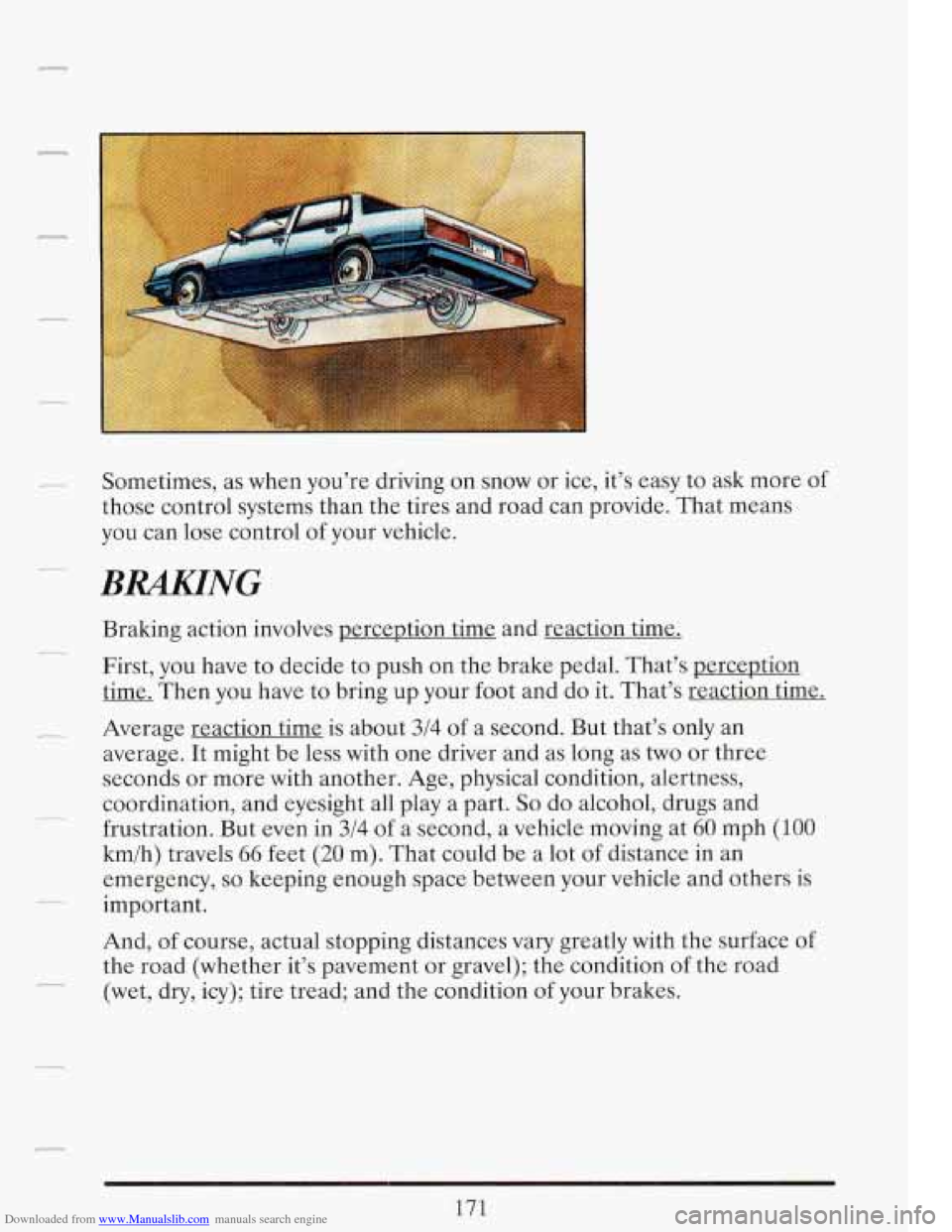
Downloaded from www.Manualslib.com manuals search engine Sometimes, as when you’re driving on snow or ice, it’s easy to ask more of
those control systems than the tires and road can provide. That means
you can lose control
of your vehicle.
BWNG
Braking action involves perception time and reaction time.
First, you have to decide to push on the brake pedal. That’s perception
time. Then you have
to bring up your foot and do it. That’s reaction time.
Average reaction time
is about 3/4 of a second. But that’s only an
average. It might be less with one driver and as long as two or three
seconds or more with another. Age, physical condition, alertness,
coordination, and eyesight all play a part.
So do alcohol, drugs and
frustration. But
even in 3/4 of a second, a vehicle moving at 60 mph (100
km/h) travels 66 feet (20 m). That could be a lot of distance in an
emergency,
so keeping enough space between your vehicle and others is
important.
And, of course, actual stopping distances vary greatly with the surface
of
the road (whether it’s pavement or gravel); the condition of the road
(wet, dry, icy); tire tread; and the condition of your brakes.
171
Page 186 of 386
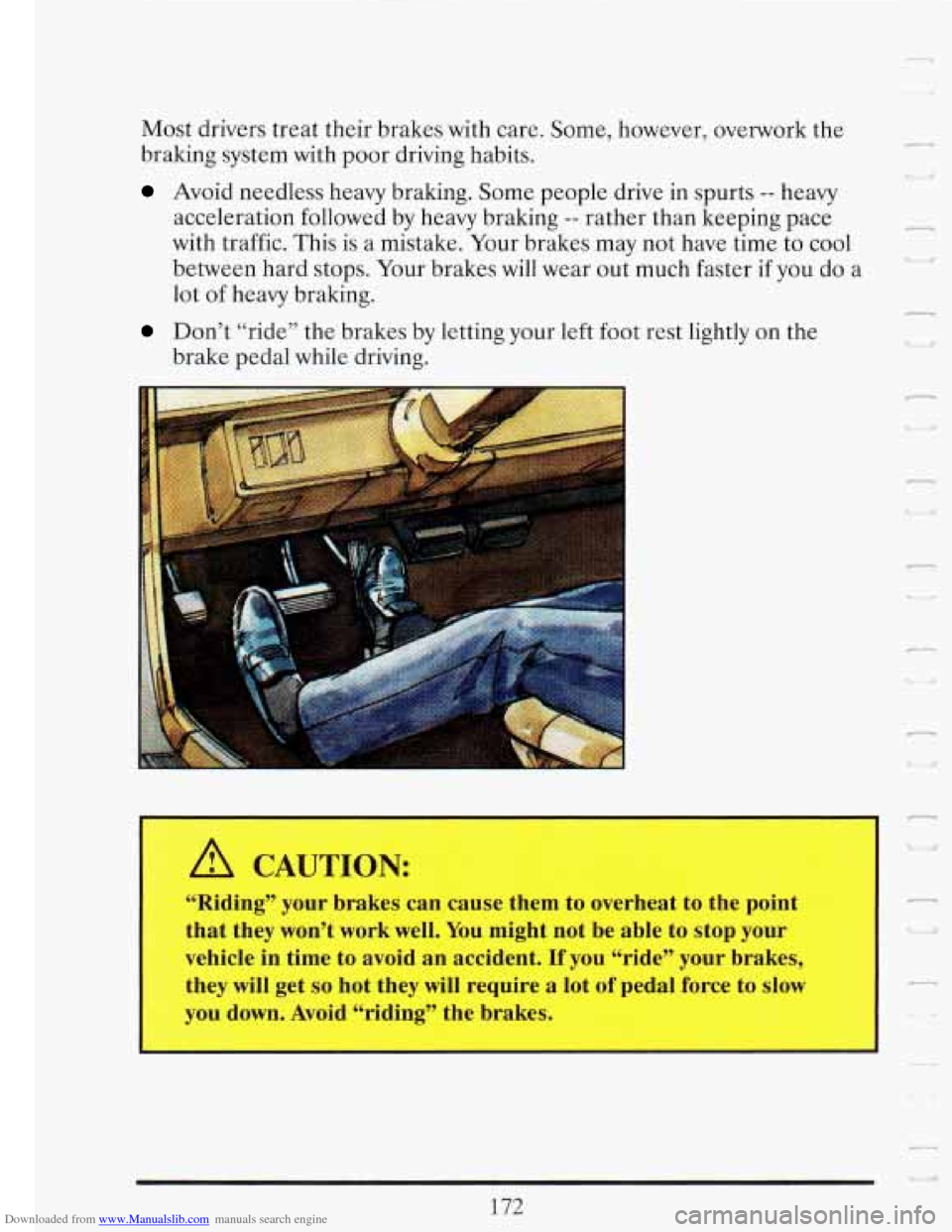
Downloaded from www.Manualslib.com manuals search engine Most drivers treat their brakes with care. Some, however, overwork the
braking system with poor driving habits.
Avoid needless heavy braking. Some people drive in spurts -- heavy
acceleration followed by heavy braking
-- rather than keeping pace
with traffic. This is a mistake. Your brakes may not have time to cool
between hard stops. Your brakes will wear out much faster
if you do a
lot of heavy braking.
Don’t “ride” the brakes by letting your left foot rest lightly on the
brake pedal while driving.
1 A CAUTION:
“Riding” your brakes can cause them to overheat to the point
that they won’t work well. You might not be able to stop your
vehicle in time to avoid an accident.
If you “ride” your brakes,
they will get
so hot they will require a lot of pedal force to slow
you down. Avoid “riding” the brakes.
172
n
I. - . il
L
Page 187 of 386
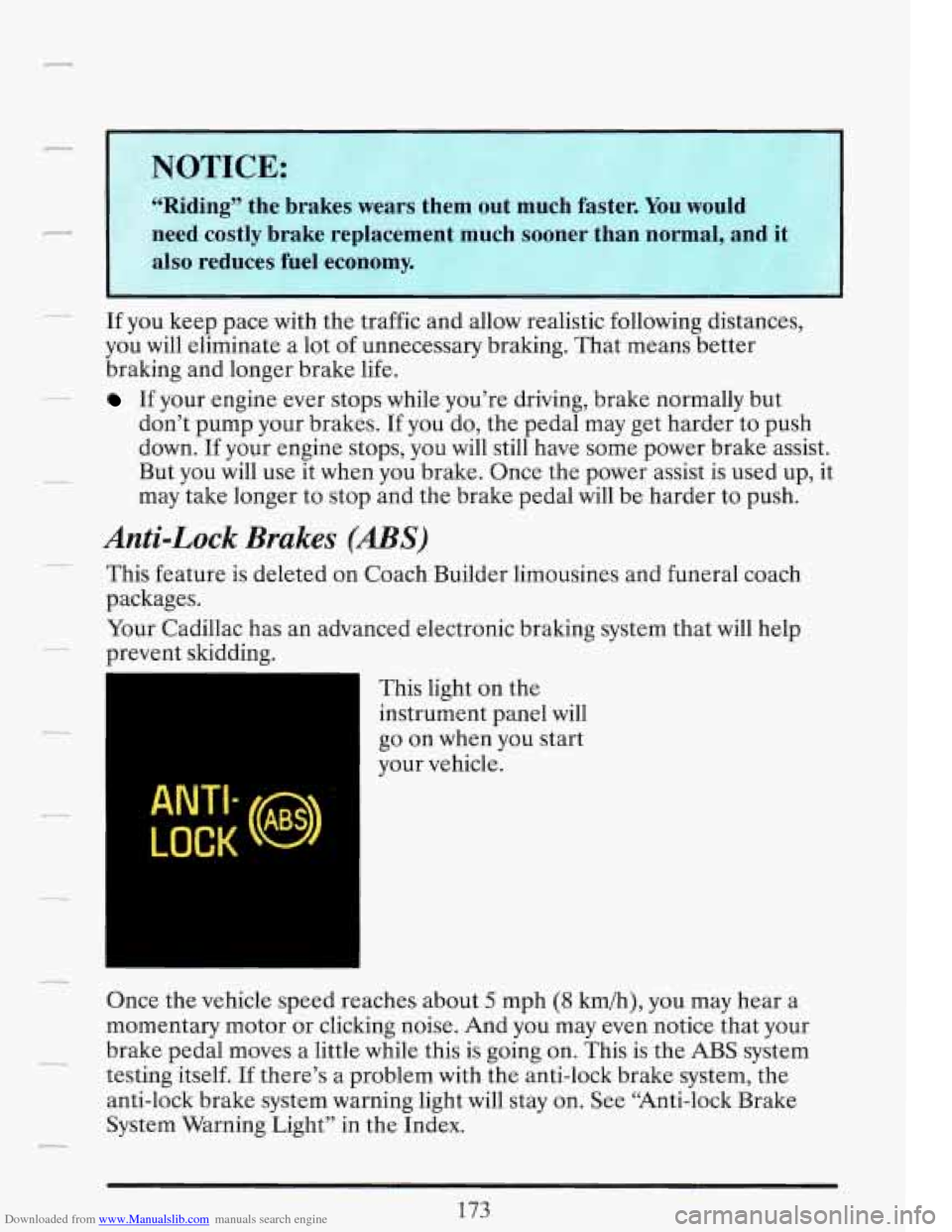
Downloaded from www.Manualslib.com manuals search engine If you keep pace with the traffic and allow realistic following distances,
you will eliminate a lot of unnecessary braking. That means better
braking and longer brake life.
If your engine ever stops while you’re driving, brake normally but
don’t pump your brakes.
If you do, the pedal may get harder to push
down.
If your engine stops, you will still have some power brake assist.
But you will use it when you brake. Once the power assist is used up, it
may take longer to stop and the brake pedal
will be harder to push.
Anti-Lock Brakes (ABS)
This feature is deleted on Coach Builder limousines and funeral coach
packages.
Your Cadillac has an advanced electronic braking system that will help
prevent skidding.
This light on the
instrument panel will
go
on when you start
your vehicle.
Once the vehicle speed reaches about
5 mph (8 km/h), you may hear a
momentary motor or clicking noise. And you may even notice that your
brake pedal moves a little while this is going on. This is the
ABS system
testing itself. If there’s
a problem with the anti-lock brake system, the
anti-lock brake system warning light will stay on. See “Anti-lock Brake
System Warning Light” in the Index.
173
Page 188 of 386
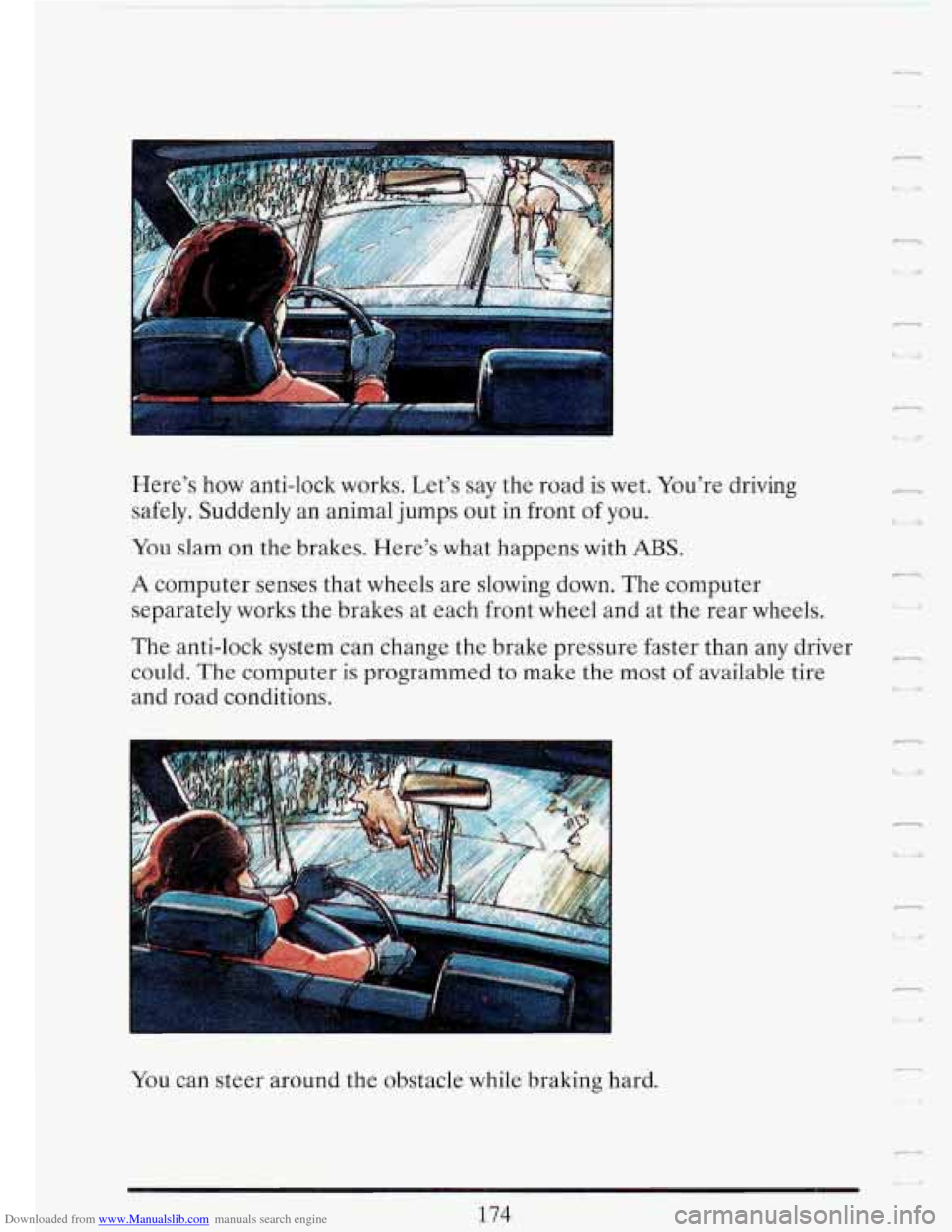
Downloaded from www.Manualslib.com manuals search engine Here’s how anti-lock works. Let’s say the road is wet. You’re driving
safely. Suddenly an animal jumps out in front
of you.
You slam on the brakes. Here’s what happens with
ABS.
A computer senses that wheels are slowing down. The computer
separately works the brakes at each front wheel and at the rear wheels.
c
U
The anti-lock system can change the brake pressure faster than any driver 7 could. The computer
and road conditions. is programmed to make the most of available tire u
n
You can steer around the obstacle while braking hard. .-
L.4
Page 189 of 386
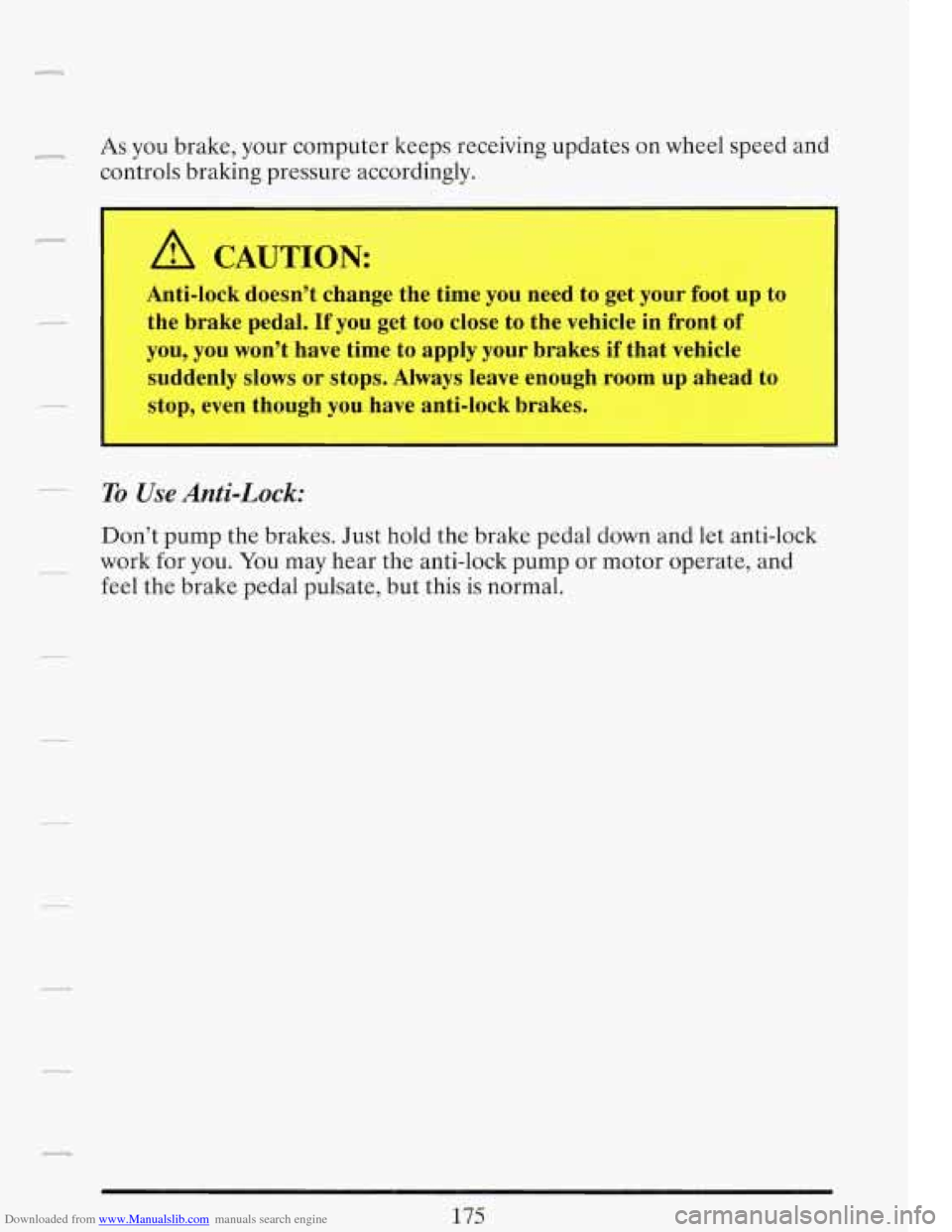
Downloaded from www.Manualslib.com manuals search engine r As you brake, your computer keeps receiving updates on wheel speed and
controls braking pressure accordingly.
r
A CAUTION:
Anti-lock doesn’t change the time you need to get your foot up to
the brake pedal.
If you get too close to the vehicle in front of
you, you won’t have time to apply your brakes if that vehicle
suddenly slows
or stops. Always leave enough room up ahead to
stop, even though you have anti-lock brakes.
To Use Anti-Lock:
Don’t pump the brakes. Just hold the brake pedal down and let anti-lock
feel the brake pedal pulsate, but this is normal.
-- work for you. You may hear the anti-lock pump or motor operate, and
175
Page 190 of 386
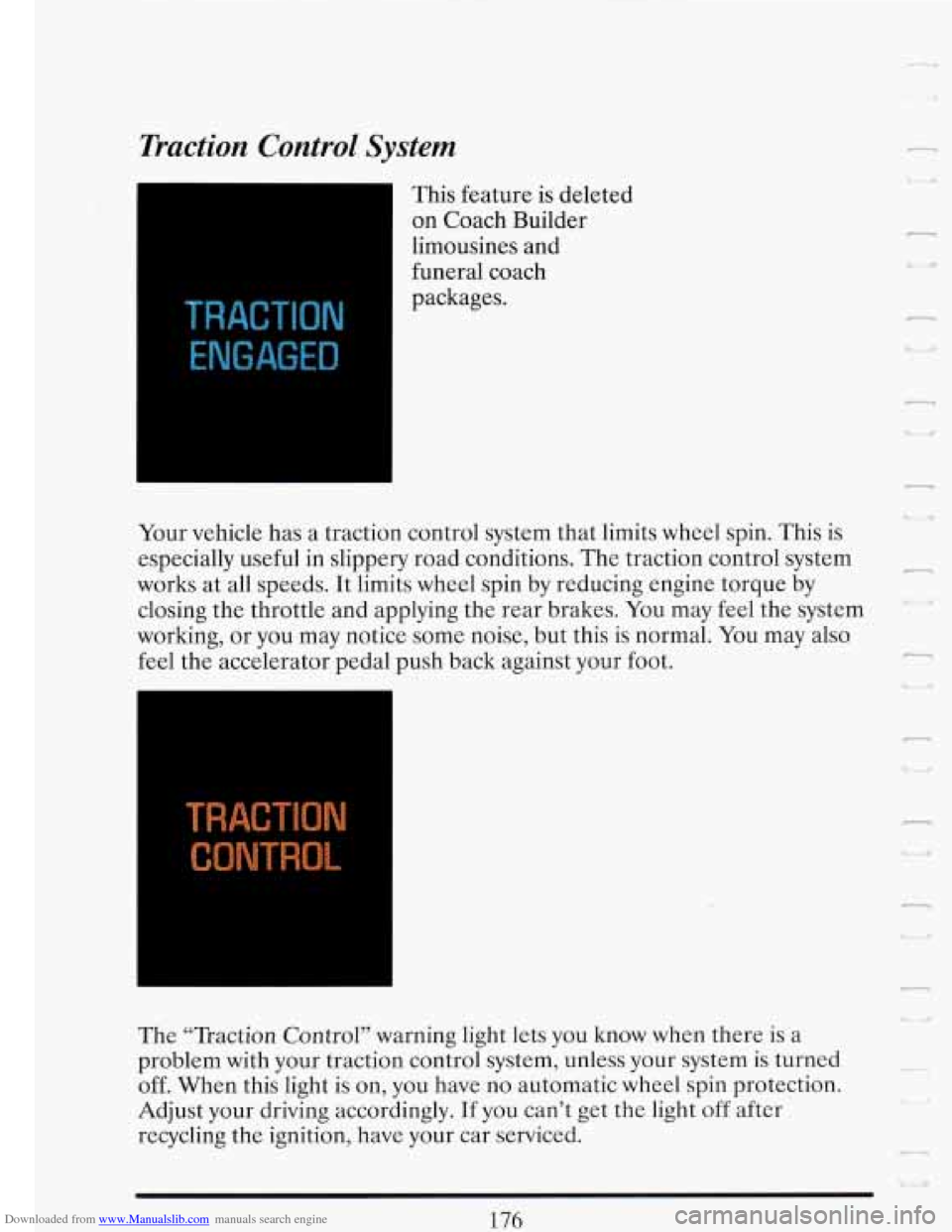
Downloaded from www.Manualslib.com manuals search engine Traction Control System
~ This feature is deleted
on Coach Builder
limousines and
funeral coach
packages. I
TRACTION
ENGAGED
Your vehicle has a traction control system that limits wheel spin. This is
especially useful in slippery road conditions. The traction control system
works at all speeds. It limits wheel spin by reducing engine torque by
closing the throttle and applying the rear brakes. You may feel the system
working, or you may notice some noise, but this is normal. You may also
feel the accelerator pedal push back against your foot.
I ~
i
TRACTION
I: I
The “Traction Control” warning light lets you know when there is a
problem with your traction control system, unless your system is turned
off. When this light is on,
you have no automatic wheel spin protection.
Adjust your driving accordingly. If you can’t get the light off after
recycling the ignition, have your car serviced.
n
u
c ‘I W
n
U
I
LrJ
-
L
..
r
1
L 7
I
UI